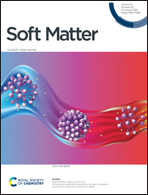Instability and rupture of surfactant-laden bilayer thin liquid films
Abstract
The stability of surfactant-laden bilayer thin films, where the top layer is subject to van der Waals driven breakup, is of particular relevance to applications where one thin liquid layer is spread on another, such as film-forming firefighting foams and multilayer coatings. Although there has been much prior modeling work on the stability of thin liquid bilayers, additional physical effects and assumptions were incorporated in those studies, making it difficult to isolate the influence of surfactant on the rupture of the top layer. The present work addresses this issue through application of the lubrication approximation to derive a coupled system of nonlinear evolution equations describing the perturbations to the liquid–liquid and liquid–air interfaces and the surfactant interfacial concentrations. The surfactant is assumed to be insoluble and can be present at each interface. Linear stability analysis suggests, and nonlinear simulations confirm, that by using surfactant that adsorbs to both interfaces, the rupture time can be increased by an order of magnitude relative to the surfactant-free case. However, we find it crucial to have the right amount of surfactant to generate strongly stabilizing Marangoni stresses without reducing the interfacial tension too much. Nonlinear simulations and linear stability analysis provide insight into the mechanisms of the delayed rupture and show how the direction and strength of the Marangoni stresses strongly depend on the viscosity ratio of the layers. These results can help guide the choice and design of surfactants to achieve more effective firefighting foams and more stable liquid coatings.



 Please wait while we load your content...
Please wait while we load your content...